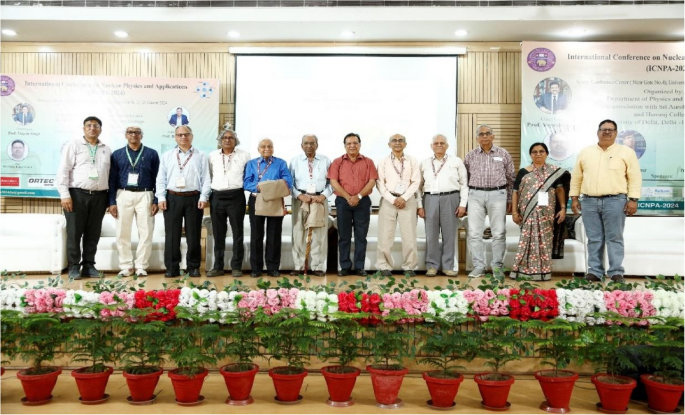Vol.35 (Apr) 2025 | Article no.11 2025
The first edition of the “International Conference on Nuclear Physics and Applications (ICNPA-2024)” (https://www.icnpa2024du.in/) was organized at the University of Delhi, Delhi, India. The conference was held at the Conference Center by the Department of Physics and Astrophysics, in association with Sri Aurobindo College and Hans Raj College, University of Delhi, from October 21 to 25, 2024. The conference was supported by the Asian Nuclear Physics Association (ANPhA) and sponsored by the Board of Research in Nuclear Sciences (BRNS), Mumbai; Konnifel; Advanced Tech Controls Pvt Ltd., Mumbai; and Redcare Research Pvt Ltd. The conference aimed to foster an interaction between young researchers and established experts in the field, providing valuable insights into both the fundamental principles and practical applications of nuclear physics. The meeting featured plenary and invited talks by experts spanning various sub-fields of nuclear physics and its applications. Young researchers were also given the opportunity to present their research findings through oral and poster presentations.
The conference successfully concluded with an impressive scientific program encompassing diverse areas of nuclear physics research. Over the five days, the conference provided a dynamic platform for the exchange of pioneering research and cutting-edge developments in nuclear structure, nuclear reactions, nuclear astrophysics, instrumentation, nuclear applications, and nuclear technology. The meeting featured 6 plenary sessions with 23 presentations from eminent speakers, 12 parallel sessions comprising 9 invited talks and 60 oral presentations, and 2 poster sessions showcasing 97 posters. Plenary talks addressed contemporary high-impact research topics from nuclear structure and shape transitions, advancements in rare isotope beams and detector technology, and interdisciplinary applications of nuclear physics. The poster contributions were distributed across nuclear reactions (53 posters), nuclear structure studies (28), nuclear applications and technology (7), nuclear astrophysics (6), and instrumentation (3).
Key research presented during the conference highlighted significant advances in the field. Topics included the use of laser spectroscopy to investigate shape coexistence in nuclei, octupole collectivity and vibrational modes in atomic nuclei, and exotic nuclear excitations explored through light- and heavy-ion beams. Advances in gas-stopping technology for rare isotope beams at FRIB, nuclear spectroscopy applications in medicine, and studies on fundamental symmetry tests further underscored the conference’s breadth. Presentations also focused on structural phenomena in transitional nuclei, precise lifetime measurements, and theoretical developments in nuclear transfer reactions, along with detector development, GEANT-4 simulations, and applications in environmental radioactivity measurement. From an application standpoint, important presentations were made by experts to showcase the developments happening in the use of nuclear isotopes and radiations in the medical field and agriculture sectors. Developments in the production and detection of exotic radioisotopes using novel techniques were also presented in the conference. This conference provided an exceptional platform for global collaboration and knowledge dissemination, emerging as a premier forum for nuclear physics and its applications.
One of the important attractions of the conference was the distribution of the Lifetime Achievement Awards. A special dedicated (evening) session was convened on the second day of the conference to felicitate 10 distinguished scientists who have made important contributions in developing nuclear physics research in India since independence. These individuals dedicated their hard work and lives to laying the foundation of nuclear physics research using the limited resources available to them. For this award, individuals from various domains of nuclear physics research were chosen by a jury of leading researchers from India and abroad. The awardees included Prof. G. K. Mehta (for nuclear applications in material science and institutional governance), Dr. S. Kailash (for nuclear reactions), Dr. R. K. Bhandari and Prof. R. G. Pillay (for accelerator development), Prof. S. C. Pancholi and Prof. Chandana Bhattacharya (for experimental nuclear physics), Prof. I. M. Govil (for nuclear structure and reactions), Dr. Amit Roy (accelerator development for medical applications), and Prof. A. K. Jain and Prof. Javid Sheikh (nuclear theory). A memento and a citation were given to the awardees as tokens of appreciation.

In the concluding session of the conference, the awards sponsored by the ANPhA for the best oral and poster presentations were distributed to the participants. The Asian Nuclear Physics Association (ANPhA) is an organization established in July 2009 to promote collaboration and cooperation among nuclear physicists across Asia. The organization aims to strengthen research in nuclear physics by facilitating knowledge exchange, coordinating resource utilization, and discussing future plans for nuclear facilities within Asia. The awardees included Dr. S. Chakraborty (pure nuclear physics) and Dr. Dhananjaya Sahoo (nuclear applications) for best oral presentations and Ms. A. Karmakar (pure nuclear physics) and Ms. Pallavi Priyadarshani (nuclear applications) for best poster presentations.
All authors read and approved the final manuscript.
All authors declared that they have no competing interests.
Springer Nature remains neutral with regard to jurisdictional claims in published maps and institutional affiliations.
If you'd like to subscribe to the AAPPS Bulletin newsletter,
enter your email below.